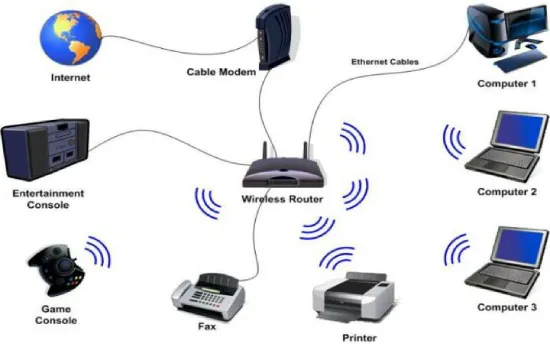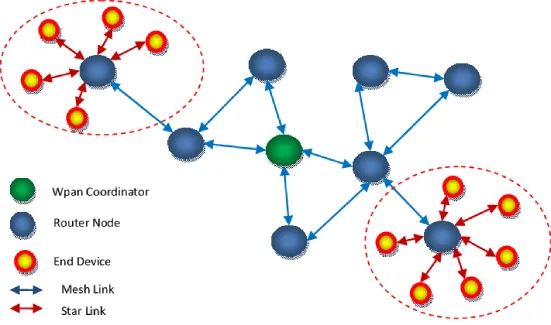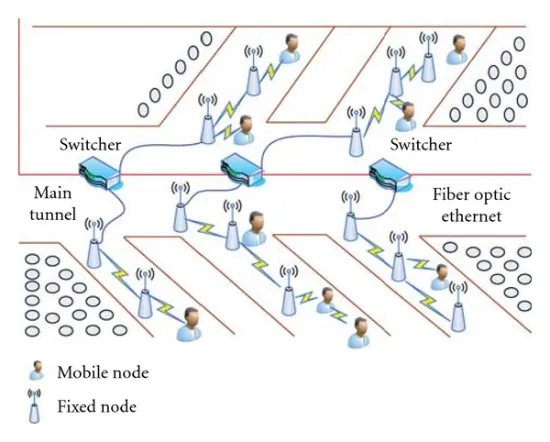What are Wireless Sensor Networks : All Explained
In recent years, the efficient design of a Wireless Sensor Network has emerged as a prominent research area. A sensor is a device that detects and responds to various inputs from physical or environmental conditions, such as pressure, heat, light, and more. The sensor's output is typically an electrical signal transmitted to a controller for further processing. This article provides an overview of the types of wireless sensor networks, their classification, types of attacks, mobility types, and routing protocols.
Wireless Communication Projects
Projects based on wireless communication primarily utilize various wireless technologies such as GPS, Bluetooth, RFID, Zigbee, and GSM. To gain a better understanding of these wireless communication technologies, we have explored them through specific projects.

Let's review some of the wireless communication-based project ideas curated specifically for engineering students. We believe these project ideas will be highly beneficial to many final-year students in successfully completing their B. Tech.
WSN Network Topologies
In radio communication networks, the architecture of a WSN incorporates various topologies, such as the ones outlined below.

Star Topologies
A star topology is a communication layout where each node connects directly to a central gateway. One gateway can transmit or receive messages to and from multiple remote nodes. In star topologies, nodes are restricted from sending messages to one another. This setup facilitates low-latency communication between the remote nodes and the gateway (base station).
Because it relies on a single node to manage the network, the gateway must be within the radio transmission range of all individual nodes. This design offers the benefit of minimizing and easily controlling the power consumption of remote nodes. The network size is determined by the number of connections made to the hub.
Tree Topologies
Tree topology, also known as a cascaded star topology, connects each node to a higher-level node and ultimately to the gateway. The primary benefit of tree topology is the ease with which the network can be expanded and errors can be detected. However, its major drawback is its dependency on the bus cable; if the cable fails, the entire network collapses.
Mesh Topologies
Mesh topologies enable data transmission between nodes within their radio transmission range. If a node needs to send a message to another node beyond its radio range, an intermediate node must relay the message to the target node. The main advantage of mesh topology is the straightforward isolation and detection of network faults. The downside is that the network's large scale demands significant investment.
Types of Wireless Sensor Networks
The choice of network type depends on the environment, allowing deployment underwater, underground, on land, and in other settings. The various types of WSNs include:
Terrestrial WSNs
Underground WSNs
Underwater WSNs
Multimedia WSNs
Mobile WSNs
Terrestrial WSNs
Terrestrial WSNs efficiently communicate with base stations and comprise hundreds to thousands of wireless sensor nodes deployed either in an unstructured (ad hoc) or structured (pre-planned) manner. In the unstructured mode, sensor nodes are randomly distributed within the target area, dropped from a fixed plane. The pre-planned or structured mode involves optimal placement, grid placement, and 2D or 3D placement models.
In these WSNs, battery power is limited, but solar cells serve as a secondary power source. Energy conservation is achieved through low duty cycle operations, minimizing delays, and employing optimal routing strategies.
Underground WSNs
Deploying underground wireless sensor networks is more costly than terrestrial WSNs due to considerations of deployment, maintenance, and equipment expenses, necessitating careful planning. These networks consist of sensor nodes hidden in the ground to monitor underground conditions. Additional sink nodes are positioned above ground to relay information from the sensor nodes to the base station.

Recharging the sensor battery nodes deployed underground poses challenges due to limited battery power and the difficult environment. Furthermore, wireless communication in the underground environment is challenging due to high levels of attenuation and signal loss.
Subaquatic WSNs
Over 70% of the Earth's surface is covered by water. These systems comprise multiple sensor nodes and vehicles positioned beneath the water's surface. Autonomous submersibles are employed to collect data from these sensor nodes. An obstacle in underwater communication includes extended propagation delay, bandwidth limitations, and sensor malfunctions.
Submerged WSNs are furnished with a finite battery that is non-rechargeable and non-replaceable. Addressing the energy preservation concern for submerged WSNs entails advancing underwater communication and networking methodologies.
Media WSNs
Media-centric wireless sensor networks have been proposed to facilitate the surveillance and tracking of events through multimedia formats such as images, videos, and audio recordings. These networks comprise inexpensive sensor nodes embedded with microphones and cameras. These nodes establish wireless interconnections to facilitate data compression, retrieval, and correlation.
The obstacles associated with multimedia WSNs encompass heightened energy consumption, increased bandwidth requisites, and the refinement of data processing and compression techniques. Furthermore, multimedia content necessitates ample bandwidth for seamless and efficient delivery.
Roaming WSNs
These networks encompass a cluster of sensor nodes capable of autonomous movement and interaction with their surrounding environment. The mobile nodes possess the ability to sense, compute, and communicate.
Roaming wireless sensor networks exhibit greater adaptability compared to static sensor networks. The benefits of RWNS over stationary wireless sensor networks encompass enhanced coverage, heightened energy efficiency, augmented channel capacity, among others.
Classification of Wireless Sensor Networks
Categorization of WSNs can be based on their applications, but their attributes primarily vary based on their types. Generally, WSNs are grouped into various classifications, including the following:
Fixed & Mobile
Deterministic & Non-deterministic
Single Base Station & Multiple Base Stations
Stationary & Mobile Base Stations
Direct & Indirect WSN
Autonomous & Non-autonomous
Homogeneous & Heterogeneous
Fixed & Mobile WSNs
In numerous applications, sensor nodes are deployed without movement, rendering these networks static. However, certain applications, such as monitoring biological systems, employ mobile sensor nodes, known as mobile networks. A prominent instance is animal tracking.
Deterministic & Non-deterministic WSNs
In deterministic networks, the arrangement of sensor nodes is predetermined and calculable. Such networks may suffice for specific applications where pre-planned node operations are feasible. Conversely, non-deterministic networks lack predetermined node locations due to factors like adverse environmental conditions, necessitating intricate control systems.
Single Base Station & Multiple Base Stations
Single base station networks utilize a lone base station positioned in close proximity to the sensor node region, facilitating node communication through the base station. Conversely, multi-base station networks employ several base stations, with sensor nodes transmitting data to nearby base stations.
Stationary & Mobile Base Stations
Base stations, akin to sensor nodes, can be either mobile or stationary. Stationary base stations maintain a fixed position, typically in close proximity to the sensing area. Conversely, mobile base stations move within the sensor region to balance sensor node loads.
Direct & Indirect WSNs
In direct WSNs, sensor nodes communicate directly with the base station. Conversely, indirect WSNs utilize both cluster heads and peer nodes to relay data, reducing energy consumption.
Self-Reconfigurable & Non-Self-Configurable
In a non-self-configurable network, sensor networks cannot configure themselves autonomously and rely on a control unit to collect data. In wireless sensor networks, sensor nodes maintain and organize the network, working collaboratively with other sensor nodes to achieve their objectives.
Homogeneous & Heterogeneous
In a homogeneous wireless sensor network, all sensor nodes have similar energy consumption, storage capacity, and computational power. In contrast, in a heterogeneous network, some sensor nodes possess higher computational power and greater energy requirements than others. Accordingly, processing and communication tasks are distributed based on these capabilities.
Types of Threats in WSNs
Various threats target wireless sensor networks, presenting diverse challenges. These threats are categorized into two primary types: active attacks and passive attacks.
In an active attack, assailants aim to alter or intercept transmitted messages within the network. They may manipulate or replay old messages, or inject their own traffic to disrupt network operations or induce denial of service.
Passive attacks involve monitoring and analyzing exchanged traffic without making any alterations. While easier to detect, passive attacks are more subtle as they do not modify exchanged data. Attackers pursue these to glean confidential information or glean insights into network topology and node data.
Examples of these threats include:
- Tampering
- Identity replication attack
- Blackhole
- Wormhole attack
- Selective forwarding
- Exhaustion
- Sybil attack
- Blackmail attack
- HELLO flood attack
- Jamming
Varieties of Mobility in Wireless Sensor Networks
In ad hoc networks, node mobility is a fundamental aspect. In WSNs, mobility primarily serves to differentiate network elements, with its relevance contingent upon specific applications. While wireless sensor network applications span diverse fields, not all necessitate mobility, emphasizing its significance in relevant contexts. WSNs feature three distinct types of mobility:
1.Sensor Node Mobility
Sensor node mobility occurs when even the slightest component of a sensor node is mobile. A prime example is when sensor nodes autonomously traverse and roam within the monitored area. This configuration finds application in animal monitoring and tracking, where sensors are affixed to animals.
2. Sink Node Mobility
In this scenario, sink nodes possess independent mobility within the monitored area to gather data from the sensor network. This mobility facilitates efficient data collection and dissemination.
3. Monitored Object or Event Mobility
This type of mobility occurs when a wireless sensor network is deployed for tracking or monitoring purposes, operating under an event-driven data model. The network dynamically responds to the mobility patterns of monitored objects or events.
Furthermore, employing movement modeling for target tracking enhances the network's predictive capabilities, aiding in estimating data generation patterns throughout the tracking process.
Varieties of Routing Protocols in Wireless Sensor Networks
A routing protocol functions as a mechanism to determine the optimal path for data transmission from source to destination. This process encounters various challenges, influenced by network type, performance metrics, and channel characteristics.
The selection of routes hinges on factors such as network topology, energy efficiency, data reliability, and latency. The diversity of routing protocols caters to the unique requirements and constraints of different WSN deployments, ensuring efficient and reliable data transmission.
Routing Hurdles
Routing protocol design for WSNs poses significant challenges due to their unique characteristics compared to traditional wireless networks. Various routing challenges arise in WSNs, some of which are outlined below.
Assigning universal identifiers to a large number of sensor nodes is exceedingly complex, rendering classical IP-based protocols impractical. Unlike conventional communication networks, WSNs must efficiently aggregate information from diverse sources to specific base stations.
Redundancy in generated data is common in WSNs, as multiple sensor nodes may detect similar information. Routing protocols must leverage this redundancy while considering available bandwidth and energy constraints.
Wireless nodes face constraints in bandwidth, transmission energy, storage capacity, and onboard power, necessitating the development of specialized routing protocols tailored to address WSN routing challenges.
Design Dilemmas
WSNs present several design challenges stemming from resource limitations such as bandwidth, processing power, storage, and energy. When crafting new routing protocols, network engineers must ensure adherence to the following principles:
Energy Efficiency
Sensor Localization
Complexity Management
Data Transmission and Models
Scalability
Robustness
Latency Management
WSN Challenges
The challenges encountered in wireless sensor networks encompass:
Fault Tolerance
Scalability
Cost of Deployment
Operational Environment
Quality of Service
Data Aggregation
Data Compression
Data Latency
Fault Performance
In WSNs, occasional sensor node failures due to power loss or physical damage should not disrupt the overall network performance. This capability to sustain network functionality despite node failures is known as fault tolerance.
Stability
With potentially thousands or even hundreds of nodes deployed in a sensing area, routing schemes must exhibit scalability to effectively handle events and maintain stability.
Production Cost
The cost-effectiveness of sensor networks heavily relies on the affordability of individual sensor nodes. Ensuring a low price per node is crucial to maintaining the overall network's production cost at a reasonable level.
Operation Environment
Sensor networks are deployed in diverse environments ranging from industrial machinery and underwater locations to chemically or biologically contaminated areas, homes, battlefields, and even on fast-moving vehicles or animals for forest monitoring. Adapting to such varied operational environments poses a significant challenge for WSN deployment.
Quality of Service
Applications demand specific quality-of-service requirements such as energy efficiency, prolonged lifetime, and data reliability, necessitating tailored approaches to meet these demands effectively.
Data Aggregation
Combining data from disparate sources using various functions like averaging, maximum, or minimum is referred to as data aggregation, aiding in efficient data processing and transmission in WSNs.
Data Compression
Reducing the size of data packets to optimize bandwidth and storage utilization is termed data compression, enabling more efficient data transmission and storage in resource-constrained WSNs.
Data Latency
Data latency, influenced by factors such as data aggregation and multi-hop relays, is a critical consideration in designing routing protocols, as it directly impacts network performance and responsiveness.
Challenges in Wireless Sensor Networks
Wireless sensor networks encounter various challenges encompassing design, topology, and operational aspects. Design challenges across different types of WSNs include:
1. Low Latency
2. Fault Tolerance
3. Coverage Issues
4. Transmission Medium
5. Scalability
Topology challenges in WSNs comprise:
1. Sensor Coverage Holes
2. Geographic Routing
3. Coverage Topology
Key issues impacting WSN design and performance encompass:
1. Operating System and Hardware Selection for WSNs
2. Middleware Implementation
3. Characteristics of Wireless Radio Communication
4. Medium Access Control Schemes
5. Deployment Strategies
6. Localization Techniques
7. Programming Models for Sensor Networks
8. Synchronization Mechanisms
9. Network Architecture Design
10. Sensor Calibration
11. Database-Centric Approaches and Querying Methods
12. Network Layer Protocols
13. Data Dissemination and Aggregation Techniques
14. Transport Layer Protocols
Addressing these issues effectively is paramount to ensuring the reliability, efficiency, and robustness of wireless sensor networks in various applications and environments.
Constraints
Wireless sensor networks face several limitations:
1. Limited storage capacity, typically in the range of a few hundred kilobytes.
2. Modest processing power, often around 8MHz.
3. Operate within short communication ranges, leading to high power consumption.
4. Demand minimal energy, constraining protocol design.
5. Employ batteries with finite lifetimes.
6. Passive devices contribute little energy to the network.
Applications of Wireless Sensor Networks
Wireless sensor networks find diverse applications in various fields:
1. Environmental monitoring, including forest detection, animal tracking, flood detection, and weather forecasting.
2. Commercial applications like seismic activity prediction and monitoring.
3. Military applications for tracking, environmental monitoring, and surveillance.
4. Health applications for tracking and monitoring patients and medical professionals.
5. Transport systems for traffic monitoring, dynamic routing management, and parking lot monitoring.
6. Rapid emergency response, industrial process monitoring, automated building climate control, ecosystem and habitat monitoring, and civil structural health monitoring.
Understanding the types and applications of wireless sensor networks provides valuable insights for practical implementation.
Temperature Sensor Selection: Types & Design Techniques Analysis
Comprehensive Guide to Common Sensors
What are Proximity Sensors ?
Intelligent Sensors: Definition, Configurations, and Utilizations
Flexible Sensor Complete Guide
What is Conductivity Sensor?
Top 10 Common Electronic Components Guide
What is a Memory Card? Types, Work, and Applications
RJ45 Connector: Everything You Need To Know (Guide)
2N7000 vs BS170: What's the Main Differences?
Understanding the Importance of Industrial Supplies










